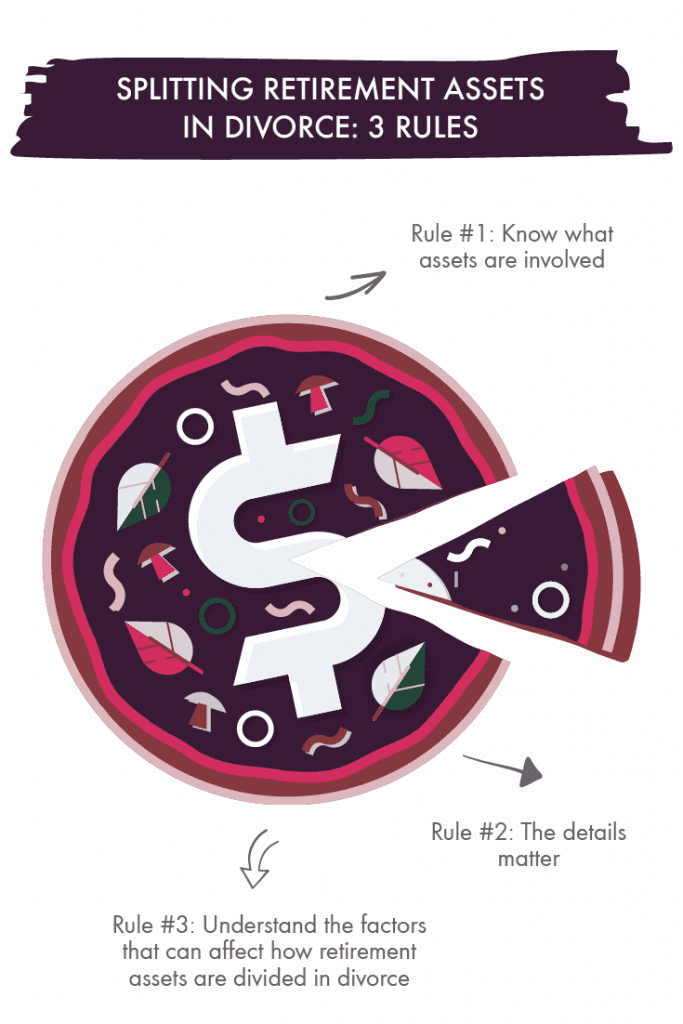
The subject of retirement assets and their division and allocation in divorce is certainly not a one size fits all discussion. The rules and regulations regarding the most common retirement investment vehicles are daunting and sometimes complicated.
Frankly, the topic can border on being overwhelming.
In order to stay engaged in this conversation, it is prudent to ground yourself with a basic approach to building your knowledge and this will then provide a solid backdrop to overlay the specific rules and regulations that apply to your own retirement asset allocation blueprint in divorce. Engaging the services of a certified divorce financial analyst® and an attorney who is a retirement specialist, can help guide you in making this foundational approach much easier.
Keep reading to learn the three basic rules of retirement assets division in divorce.

Review all available documentation to determine all of the retirement accounts that are in issue and make a list of them with relevant account numbers.
Here are some of the more common retirement account categories:
Generally, defined pension benefit plans, 401k, 403b, and similar plans require the preparation of a qualified domestic relations order (QDRO) which is submitted to the employer for approval and filed with the court as a part of the divorce documents.
There are generally plan documents or other written guidance regarding the rules and requirements of retirement plan accounts. If there is documentation (or if this documentation can be obtained through the required disclosure forms for divorce proceedings) of the plan documents for these assets, make sure you can work with someone to review this information. Larger company employers generally have well-known plan management firms who compile this information for employee distribution.
Definitions, company procedures for liquidating and/or transferring retirement assets in divorce, explanations of tax treatment, etc. can be found in this documentation.
Additionally, review the recent account statements to determine the balances in each account that are on the table for distribution. Depending on your jurisdiction, the balance amounts are evaluated on the date of separation or current to date.
If your spouse is the account holder, it may be challenging to access this information without enforcement from your attorney via subpoena or discovery document requests such as interrogatories or requests for the production of documents.
Take a look at this resource which will give you an idea of what type of general information to focus on at this stage.
There are numerous considerations that can fold into your discussions on the allocation of retirement assets. Why? Because plans have different requirements and procedures and often the employee spouse has made certain decisions regarding these plans at the beginning of employment that may affect benefits for the non-employee spouse. Here are a few things to keep in mind.
The laws of a particular jurisdiction also impact these allocations so make sure you understand the requirements of your state of residence. The division of retirement assets will be affected differently depending on how the jurisdiction (community property, equitable distribution, common law) treats marital assets.
If your jurisdiction follows the community property approach for example, the valuation may rely on an equal division of the account value. Equitable distribution jurisdictions may consider other financial aspects of the marital and separate property estate in deciding how to divide up the retirement account(s) value.
Termination, death, and disability can impact how and when retirement benefits become available. The timing parameters in the retirement plan prospectus for the employee spouse will provide the process for exercising rights and they will also generally provide a set time period for the continuation of benefits.
Generally, at the start of employment, there is an opportunity to elect how certain benefits will be handled at retirement and upon death. If you are the spouse who would receive retirement benefits from the other spouse, it is important to know whether the election was made for a life annuity or joint survivor annuity. The former will result in benefits that expire upon the death of the employee. The latter will allow the surviving spouse to continue to receive the allocated benefits. This could be a key issue if the post-retirement income budget depends upon these funds to maintain lifestyle choices.
This is a key consideration in divorce as often the non-employee spouse has developed a budget that relies on the receipt of these funds for living expenses. If they terminate unexpectedly or if the benefits will not be received at all for some reason then it may be necessary to make up this shortfall by a larger allocation of other financial assets.
Knowing what to look for and determining the amounts currently for allocation in retirement account categories will set the stage for allocating these resources in conjunction with retirement plan documents, federal law and the laws of your local jurisdiction.
©2011-2024 Worthy, Inc. All rights reserved.
Worthy, Inc. operates from 25 West 45th St., 2nd Floor, New York, NY 10036